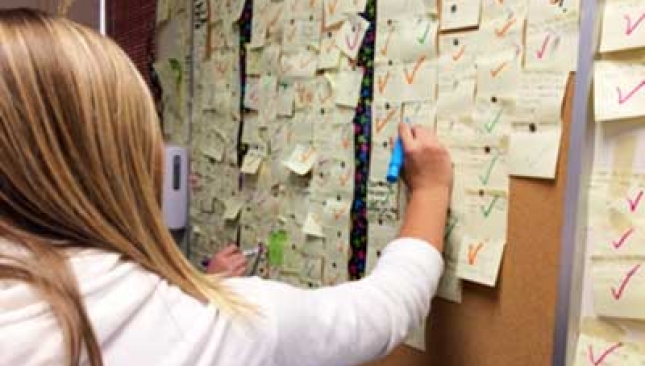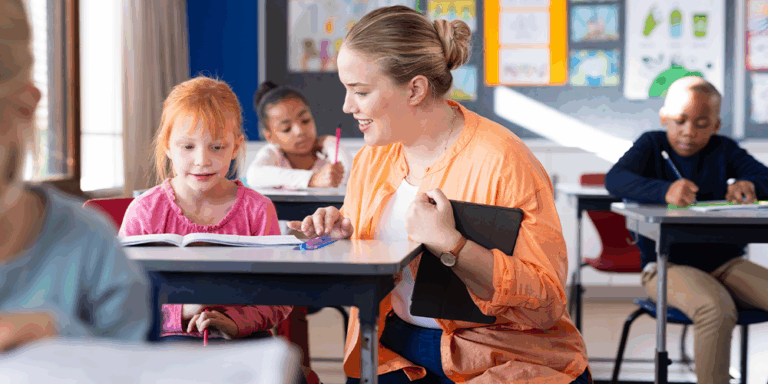Have you ever interviewed a group of your students about their experiences in your classroom? It is amazing how much you can learn from your students’ perspectives, especially when you are experimenting with new methods.
Last June, a visit from the Right Question Institute prompted me to meet with a group of my students and ask them about how the Question Formulation Technique (QFT) process impacted their learning in my science class. As I am relatively new to implementing the NGSS (Next Generation Science Standards), I was curious (and even a little anxious) to hear what they would say about how I had combined the QFT with the new standards.
I was blown away. One of my favorite quotes from a student was, “I feel like I have so much that I want to learn. When I’m asking questions, I can’t wait to learn the answers to my questions.” Another student shared, “In the past, we were told what to do, but when we ask the questions … we create the learning.” These powerful statements showed me that when my students became comfortable generating scientific questions, they felt empowered and in control of their learning. Asking their own questions motivated my students to want to learn about scientific phenomena.
According to the NGSS, students need to learn and practice generating scientific questions. Because this skill is new and challenging for many students who are used to answering questions in school, I realized that I needed to figure out a structure with which to train my students. The QFT fit the bill. As my students and I became more familiar with the QFT process in science, I became comfortable trying new “twists” and variations within the QFT structure. With a lot of practice and experimentation, I figured out how to help all of my students feel more comfortable asking scientific questions.
Drawing on my continuous practice of the QFT over the past six years and what I learned from listening to my students, I’ve identified five key steps to help students successfully use the QFT to investigate puzzling phenomena through their own questions.
1. Engage Students in Goal-Setting and Self-Assessment
I’ve found it critical to engage my students in setting clear goals for themselves, prior to beginning the QFT, as a way to clarify expectations, ensure participation, and make progress visible to students over the course of the year.
Students appreciate clear expectations of how to generate questions as a scientist. Using a rubric I created based on the NGSS science and engineering practices and the QFT guidelines, students self- and peer-assess progress when doing the QFT. This process encourages active participation, collaboration, consistency, reflection and ownership. Notice that the rubric focuses on these metacognitive and behavioral expectations, not the quality or content of the questions students ask. Grading the questions that students generate may discourage some students from asking anything, for fear that it may not be a “good enough” question, earn a poor grade, or be judged.
Goal setting also helps students envision what they need to work on during the QFT process. I usually ask students to read the rubric and choose a specific skill and level they would like to work on. Students then write their specific goals on a Post-it note and keep it with them throughout the QFT process so they can refer back to it. For example, one student’s goal was, “I want to help my partner ask questions if he gets stuck.” Another goal was, “I would like to ask a bunch of questions and ask over three questions by adding off of my partner’s.”
At the end of the activity, students revisit and reflect on their QFT goals. To celebrate and recognize students who successfully worked hard to practice their QFT skills and grow from the experience, I like to end class with a brief discussion in which students share examples of their partners’ successes.
2. Choose an Accessible, Interesting Phenomenon as a Question Focus
I love to watch students’ reactions as I introduce a new phenomenon. Students are always amazed by one video about a baseball team that plays at midnight every year in Alaska. As a woman in the video looks at her cell phone, which reads midnight, but there’s still plenty of daylight, jaws literally drop and I can see several faces bursting to ask questions about it.
It is important to choose a phenomenon that will peak your students’ curiosity so that all students are able to ask questions. For example, in order to introduce the NGSS disciplinary core idea (DCI) “Earth’s Place in the Universe,” I show the midnight baseball game in Alaska rather than a diagram of the solar system or picture of phases of the moon. Many of my students can relate to sports and all of them understand that midnight is typically late, and quite dark, so this video really works for them. Another example of a relatable phenomenon to trigger questioning around the DCI “Energy,” is a video of chocolate ice cream melting in slow motion. Because the majority of my students relate to melting ice cream, they’re eager to generate questions that ultimately lead to their learning about thermal energy transfer.
It takes practice and experimentation to find a phenomenon that hooks your students. One of the first times I tried the QFT process, I showed students a picture of a large pulley as a Question Focus (Q Focus), thinking it would trigger a lot of questions around energy and simple machines. However, I found that students struggled to connect to this image because many were unfamiliar with it and could not make the connection to the concept of energy. Since that first time, I now first present new QFocus ideas to my husband, my own children, and sometimes other teachers to help me gauge how my students will react. I even ask them to generate a few questions. By testing the QFocus on others, I am able to get a better sense of what types of questions my students might ask. I also make sure to study the NGSS disciplinary core ideas before I come up with a relevant and interesting phenomenon to be sure that I have a strong understanding of the essential questions students must ask in order to learn the necessary skills and scientific information.
3. Create a Space for Students to Post Their Questions Both Digitally and Non-Digitally
After students produce questions, prioritize them, and reflect on the process and their individual goals, we move into creating a Driving Question Board (DQB).
Generally, students work to identify categories or patterns of questions and then as a class, we narrow down to one central question and a few supporting questions. As a community of scientists, we discuss and prioritize what’s most important to answer in order to understand the phenomenon. Students write their priority questions on Post-it notes and organize them under the appropriate sub-categories. Students also create a digital version of the DQB by typing into a shared Google Doc.
Another DQB could look like the image below where I color coded each class. Each class came up with their own main questions and sub-questions. An additional step I tried was presenting students with the most common main question and sub-questions. Students then voted as a way of choosing the final main question and sub-questions.

One student reflected, “If you look at the Driving Question Board, you can see some of the thoughts other students have.” He also explained that he sometimes reads questions that he never thought about and he becomes more curious and anxious to learn.
4. Prepare for the Unexpected Questions!
Since you never fully know what students will ask before you do the QFT process, you should be prepared for some unexpected scientific questions. While my students ask remarkably consistent questions from year to year and class to class, there are always a few that are totally new, “outside of the box,” somewhat off-topic or not quite aligned with the lesson I had planned.
So, what to do with unexpected questions? I like to create a “parking lot” bulletin board and invite students to post questions that weren’t selected as priority questions but that they’re still really interested to learn more about. To provide evidence, “parking lot” questions can be addressed with a brief article or video. I expose students to TED-Ed videos which are a wonderful, reliable resource for students to explore “parking lot” questions independently. Students can grab a parking lot question and do some research as a “do now” activity. Sometimes, these questions are great enrichment for students who achieved a solid understanding of the phenomenon and are ready to explore further.
My students are often excited about their parking lot questions even though we do not always have a chance to answer all of them. In fact, the unanswered questions just make them more curious! Some students are so intrigued by the “parking lot” questions that they spend their free time researching the answers. I find that many of the “parking lot” questions result in students discovering how many concepts in science are related to each other. For example, when students were asking questions about a phenomenon related to sound waves, many students asked questions about hearing and the ear. I did not originally plan for students to learn about how the ear works, but realized that one of the NGSS DCI’s is “From Molecules to Organisms: Structures and Processes.” This DCI relates to the structures and functions of the human body and could include the physiology of ear. Students were able to relate how the human ear works to process sound waves.
5. Actually USE Students’ Questions and Make it Public
A big part of the success of the QFT in my classroom is that students quickly learn that I use the questions they produce. As one student said, “At the beginning of the year, we were asking questions just because we had to get to a certain number. Now we ask questions because that’s what we’re actually going to learn about so what you ask really matters.” Students know that their questions will appear and re-appear throughout every unit and, in fact, guide most of what we are learning. In other words, the QFT isn’t a one-off activity; it is embedded into the structure of our units and the culture of our class.
Below are the typical next steps we take after the initial QFT process is complete, (2-3 weeks):
- Students predict and type answers to the QFT questions in the digital Driving Question Board.
- Students generate initial models of their preliminary ideas related to their main and sub-questions. They then participate in a gallery walk and discussion to make their initial thinking public to their peers.
- Students investigate their QFT questions, even some “parking lot questions,” through investigations, experimentation and research.
- Based on new learning, students revise their initial models.
- Based on new learning, students add more questions to the Driving Question Board and revisit and revise answers to their questions.
- Students check off answered questions (on posted DQB)
- Finally, a condensed form of the Driving Question Board is “published” as posters which are hung around the room after exploration is complete. By the end of the year, posters line the entire perimeter of the classroom. Making these posters visible and public is critical because it honors the work and learning students have done. Often, students glance at these posters and make connections between phenomena throughout the year. It also helps them to remember what they learned and ask even more questions. The posters remind my students that asking questions is a worthwhile activity because it will lead to further learning about their curiosities.

During my very valuable interview with my students, one described doing the QFT process with NGSS-focused phenomena as “a time when you can let all of your questions out about a topic.” Another student said, “If you don’t ask a question, it’s a missed opportunity to learn new things.” Their statements showed me that these students understood how important it is to develop and practice questioning skills in and out of the classroom because they realized that questioning leads to learning. They also understood that their questions mattered because they were provided multiple opportunities to publish, explore, and answer their questions. Other students reported that “by asking what you want to know, you control where it is going more and you work harder to get the answer,” and “doing QFT makes me feel like I’m in control of my learning and that it’s not just the teacher telling us what to do. We can ask questions and learn about what we want to learn.” My students made it clear to me that they value having choice in what they are learning in science, especially when it comes to an intriguing, accessible phenomenon.








